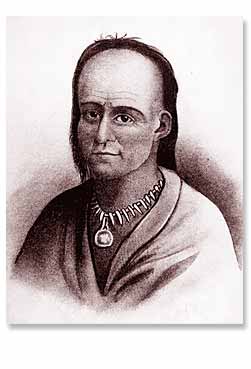

Hailed
as the last Chief of the Miami Indians, he was born in 1782 near Devil?s Lake,
northwest of Churubusco in Whitley county, Indiana. Little Turtle was the son of
the Miami chief Acquenacke and a Mahican mother. His grandfather, Osandiah, was
chief at the time of the Battle of the Johnston farm (as it is now called) in
1763. When the tribe ceded their last Indiana reservation in 1838 to the
Government, they gave Me-Shin-Go-Me-Sia ten sections of land in Grant County,
Indiana.
He
led the confederation of Indians that defeated General Arthur St. Clair, at Fort
Recovery on November 3, 1791. His force inflicted the worst defeat ever suffered
by the U.S. Army at the hands of native Americans. St. Clair's army consisted of
1300 soldiers. In the battle, 602 were killed and about 300 wounded. The Indian
force consisted of approximately 1000 warriors. Only 66 Indians were killed in
this battle! It was the greatest defeat the Americans ever suffered at the hands
of the Indians. Even worst than the loss suffered at the Battle of Little Big
Horn or Custer's Last Stand. Custer only lost about 210 men compared to St.
Clair's loss of 602 killed! Me-she-kin-no-quah lived the village of Ke-ki-ong-a'.
Kekinonga means blackberry patch. This was the Miami capitol (Ft. Wayne, IN).
He
fought later against United States militias that had been punishing his and
other tribes for raiding settlements in the Northwest Territory. He led defeats
of Gen. Josiah Harmar's and Gen. Arthur St. Clair's troops in the early 1790s.
Little Turtle and his warriors were not beaten until 1793, when Gen. Anthony
Wayne and his garrison routed the Miami at the battle of Fallen Timbers in
August 1794. This defeat effectively put an end to two decades of warfare. The
battle site is now a state park southwest of Toledo, Ohio.
In
1795 Little Turtle signed the Treaty of Fort Greenville, ceding Indian lands in
Ohio, Illinois, Indiana, and Michigan by a confederacy of Indians known as the
Northwest Indian Confederation. The confederation included Miami, Chippewa,
Iroquois, and others. Afterward, Little Turtle advocated peace and kept his
people from joining Tecumseh's confederacy. Little Turtle also encouraged his
people to abstain from alcohol, to develop new farming techniques, and to be
vaccinated against smallpox. He met with George Washington in Philadelphia in
1797. His portrait was painted by Gilbert Stuart before Little Turtle died on
July 14, 1812, in Fort Wayne, Ind.
